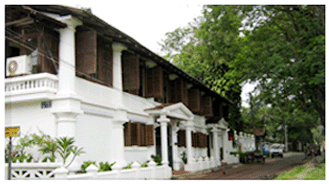 |
|
Bernard bungalow holiday home is a family run homestay which is a dutch heritage building ,facing the greenery of the parade ground and the St Francis Church the first European church in India , a little distance away is the Santa Cruz Basilica ,Vasco DA Gama tomb ,Beach ,Chinese fishing nets, Head post office,Dutch Cemetery ,Banks ,Bus terminal,Ferry ,Restaurants and shopping area.
We started accommodating our guests from different parts of the world, inSeptember 2006. We offer nice, spacious & clean rooms with attached private European style toilets. The rooms have comfortable twin-beds & the bathrooms, 24 hours hot/cold water.
The six large and airy bedrooms of the house need no air-conditioning. The bathrooms attached to the bedrooms offer both cold and warm water options. This stately heritage home and its estate provide facilities for both rest and recreation.
Parade Ground
 |
|
The colonists conducted their military parades and drills. The building around the ground housed their defense establishments. Today, the largest open ground in Fort Cochin , the parade ground is a sports arena.
|
The United Club
One of the four elite clubs of British Cochin, the United Club today serves two roles- as a class room for the nearby St. Francis Primary School by day and card room for the current listed members by evening. Until 1907 the building housed the offices of Fort Cochin Municipality .
The Bishop’s House
Built in 1506 as the residence of the Portuguese Governor, the Bishop’s House stands on a little hillock near Parade Ground. The façade of the house is characterized by large Gothic Arches and has a circular garden path winding up to the main entrance. The building was acquired by Dome Jos Gomes Ferreira, the 27th Bishop of the Diocese of Cochin whose jurisdiction extended over Burma , Malaya and Ceylon in addition to India . A powerful man for his time.
Fort Immanuel
This bastion of the Portuguese in Cochin was a symbol of the strategic alliance between the Maharajah of Cochin and the Monarch of Portugal, after whom it was named. Built in 1503, the fort was reinforced in 1538. By 1806 the Dutch, and later the British, had destroyed most of the fort walls and its bastions. Today, remains of this once imposing structure can be seen along the beach.
The Dutch Cemetery
The tomb stones here are the most authentic record of the hundreds of Europeans who left their homeland on a mission to expand their colonial empires and changed the course of history of this land. The cemetery was consecrated in 1724 and is today managed by the Church of South India .
|
The Portuguese
Walking through Fort Cochin will transport you back to the last years of the 15 th century. When the adventurous Vasco da Gamma and valiant Cabral let their religions to this land lured by the fabulous riches of Malabar Coast and established flourishing trade relations.
In 1553 with the permission of Maharaja of Cochin, Fort Immanuel , the first European Fort in India was constructed here. Within its vast confines, the Portuguese built houses, Churches and other buildings while generously contributing to the indigenous cultural fabric, the standard of which still endures.
The Dutch Designs
While traveling down the streets of Fort Cochin , the Dutch influence is profound, they laid out most of the town in its present form. In doing this, they cut down the Fort to about a third of its original extent, when they wrested it from the Portuguese in AD 1663.
During the Dutch era, Fort Cochin climbed the heights of fame as a rich commercial center, major military base, an illustrious cultural hub, a noted ship building yard and an age old center of Christianity.
The British
The last side of colonial regime seen at the Fort Cochin are those of British, who took over the town in 1795.After those glorious years it was then relegated to the role of an administrative outpost. Yet, the spices and tea trade kept it in the lime light. In many of the Bungalows here, you will notice the grandeur of European Villa; evidence of distinct strain of Indo/European Architecture that matured mostly in this period. |
|



